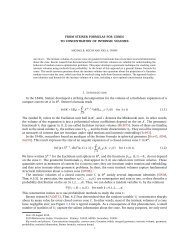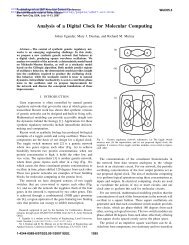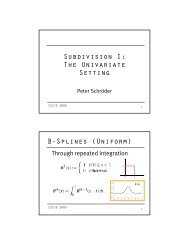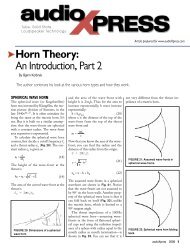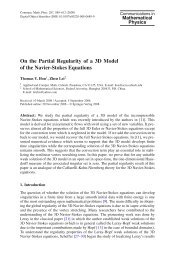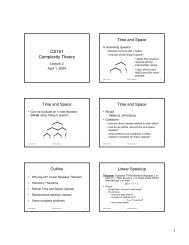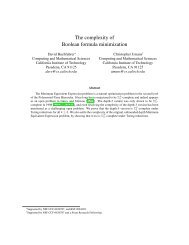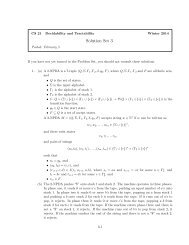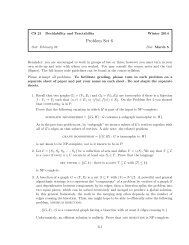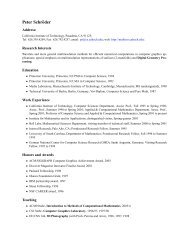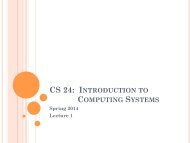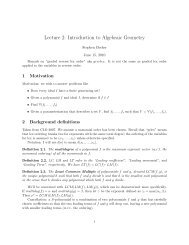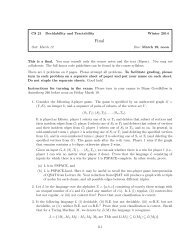FLOWS WITH SURFACE TENSION 335singularity, and at t--0.46 all <strong>the</strong> modes lie above <strong>the</strong>round-off. Then, as seen in Fig. 17c, energy begins to move<strong>from</strong> high wavenumbes back to low wavenumbers. Forexample, <strong>the</strong> highest nonzero mode at t--0.60 is aboutk = 450 and by time t = 1.20, it moves to about k = 360. Thisbehavior reflects <strong>the</strong> saturation observed in 7 and x.Between t = 1.20 and t = 1.40, <strong>the</strong> energy resumes its generationat high wavenumbers (refocussing) and by t = 1.40, allmodes again lie above <strong>the</strong> round-off.7.3. Boussinesq InterfacesIn this section, a preliminary long time computation ofan interface in an unstably stratified Boussinesq flow ispresented. In Boussinesq flow, <strong>the</strong> fluids are only weaklystratified across <strong>the</strong> interface and <strong>the</strong> only contribution tovorticity production is through <strong>the</strong> buoyancy term. Weremark that Boussinesq interface flows in <strong>the</strong> absence ofsurface tension develop finite time singularities of a formwell described by those for inertial vortex sheets <strong>with</strong>outsurface tension [ 37, 5 ]. The 7 evolution equation isV,-~3~((T-W.s)7/s~)=Sx~-2Ry~. (100)The term Q in <strong>the</strong> small scale decomposition (56) is replacedb'y Q-2Rye. The Crank-Nicholson scheme is used <strong>with</strong>filtering for <strong>the</strong> same initial data in x and y as in <strong>the</strong> inertialvortex sheet calculation. Initially, 7 = 0. Fur<strong>the</strong>r, R = -- 5 sothat <strong>the</strong> flow is unstably stratfied, and <strong>the</strong>re are 19 linearlyunstable modes.Figure 18 shows <strong>the</strong> time evolution of two periods of <strong>the</strong>0.5.0.05 - -(a)0 0.5 1t=01.5 2(c)0.5(b)0 . 5 ~ 0-0.50 0.5 1 1.5T=0.60(d)0.501-0.5 0 0.5 1 1.5 2 0 0.5 1 1.5T=0.70T=0.80(e)(f)0.5 0.10 0.5 1 1.5 2 0.15 0.2 0.25 0.3T--0.89T=0.89FIG. 18. Evolution ofa Boussinesq interface; S = 0.005, R = - 5, At =3.125x 10 -5 , N= 1024: (a) t=0; (b) t=0.60; (c) t=0.70; (d) t=0.80;(e) t = 0.89; (f) close-up of a left-most spiral, t = 0.89.0.35interface. This computation uses N=1024 and At=3.125× 10 5. The classical Rayleigh-Taylor structure isseen as two spirals form on ei<strong>the</strong>r side of <strong>the</strong> fluid plumes.The spirals are smaller than those for <strong>the</strong> inertial vortexsheet, but an examination of <strong>the</strong>ir inner structure shows<strong>the</strong>m to be very similar. In particular, note <strong>the</strong> inward bulgein <strong>the</strong> second turn of <strong>the</strong> interface (t = 0.89, close-up). Itseems very plausible that <strong>the</strong>re will again be finite timepinching. One consequence of <strong>the</strong>se smaller spirals is thatthis flow is more difficult to resolve than <strong>the</strong> previous caseof inertial vortex sheets. More highly resolved computationswill be presented in a separate study [28].An intriguing question is whe<strong>the</strong>r such "bubble" formation,as is apparently predicted by <strong>the</strong>se calculations, isobservable in an experimental setting. Of course viscosity(and dimensionality) are crucial effects as <strong>the</strong> singularity isapproached. But in his experimental study of <strong>the</strong> developmentof instability in sharply stratified shear flow betweentwo immiscible fluids, Thorpe [ 50 ] remarks that <strong>the</strong> interfacebetween <strong>the</strong> two fluids "became very irregular, sometimesbeing broken and drops of one fluid being producedin <strong>the</strong> o<strong>the</strong>r,...".8. CONCLUSIONSIn this paper, we present new numerical methods forcomputing <strong>the</strong> motion of a fluid interface <strong>with</strong> surface tensionin a two-dimensional, irrotational, and incompressiblefluid. These methods have no high order stability constraint,are effectively explicit, and have high spatial accuracy. Ourmethods are applied to computing <strong>the</strong> motion, in 2D, ofinterfaces in Hele-Shaw flows (viscously dominated) and to<strong>the</strong> motion of free surfaces in inviscid, inertially dominatedflows governed by <strong>the</strong> Euler equations.In <strong>the</strong> former case, we compute <strong>the</strong> long-time developmentof an expanding gas bubble and a complicated"mixing zone" by <strong>the</strong> interpenetration of a heavy fluid <strong>with</strong>a lighter one. We show <strong>the</strong> robustness and accuracy of <strong>the</strong>method, even in <strong>the</strong> presence of ramified spatial structure. In<strong>the</strong> latter case, we compute <strong>the</strong> long-time evolution of avortex sheet: The simulations suggest that in <strong>the</strong> process offorming a spiral, <strong>the</strong> turns of <strong>the</strong> spiral collide <strong>with</strong> oneano<strong>the</strong>r, creating trapped bubbles of fluid. The results alsoindicate that this behavior is strongly tied to <strong>the</strong> presence of<strong>the</strong> surface tension, which allows <strong>the</strong> creation of localcirculation along <strong>the</strong> sheet. To our knowledge, such asingularity has not been previously observed in such a flowin 2D.These methods are finding application in problemsbeyond those discussed in this paper. To study <strong>the</strong> "quasistatic"limit of dendritic crystal growth, Almgren, Dai,and Hakim [ 1 ] have recently applied our methods tocomputing <strong>the</strong> expansion of a Hele-Shaw bubble <strong>with</strong>anisotropic surface tension. By being able to compute for
336 HOU, LOWENGRUB, AND SHELLEYlong-times <strong>with</strong> good resolution and moderate time steps,<strong>the</strong>y have discovered new scaling behaviors in <strong>the</strong> expansionand propagation of <strong>the</strong> large scale fingers• In collaboration<strong>with</strong> A. Greenbaum and D. Meiron, we have impleted <strong>the</strong>second-order linear propagator method, toge<strong>the</strong>r <strong>with</strong> fastsummation methods, to compute <strong>the</strong> many inclusionOstwald ripening problem. Preliminary results indicate that<strong>the</strong> linear propagator method is substantially faster than anearlier implementation that used a standard ODE solver forstiff systems.APPENDIX 1: SMALL SCALE DECOMPOSITION OFINTEGRAL EQUATIONIn this appendix, it shown that at small scales, <strong>the</strong> integralequations for Hele-Shaw interfaces and inertial vortexsheets yield explicit relations for y and Yt, respectively. Bothintegral equations can be written as~(a, t)+ K[~](ot, t)=f(a, t), (101)where ~ is <strong>the</strong> funcion to be determined (i.e., 7 or 7t) andfcontains all <strong>the</strong> terms not involving ~. K is <strong>the</strong> integraloperator and is given byf+ct)K[~](ot, t)= -2A ~(a', t)--ooxRe 2hi z(~,t)-z(ot',t) do~', (102)where A=Au (Hele-Shaw) or Ap (inertial sheets) and[A[ ~< 1 in ei<strong>the</strong>r case. The integral equation (101) is aFredholm integral equation of <strong>the</strong> second kind and it is wellknown that it is invertible and has a bounded inverse on anopen and periodic geometry if z is smooth in 0~ (see [ 6 ] ).Moreover, if <strong>the</strong> components of <strong>the</strong> complex interfaceposition z satisfy <strong>the</strong> assumptions of Theorem 1 (Section 4),<strong>the</strong>n it is easy to see that <strong>the</strong> integral kernelz( Zz(ot,)j(103)is a smooth function. Thus, K is a smoothing operator. Asin Theorem 1, this means that for any ~k e L 2 <strong>the</strong> highwavenumber behavior of K is given by/~[ ~k ] (k) = O(e -P Ikt~(k)), (104)where p is <strong>the</strong> assumed strip width of analyticity of z in ot.Consider <strong>the</strong> integral equation (101). It can be invertedformally to give~ = (1+ K)-lf, (105)where I is <strong>the</strong> identity operator. Moreover, <strong>the</strong> boundednessof <strong>the</strong> inverse implies that if f eL 2 <strong>the</strong>n so is (I+K)-lfFur<strong>the</strong>r, Eq. (101) can be rewritten as~ =f--K[~] =f-K[(I+K)-~f] (106)by using (105) only on <strong>the</strong> right-hand side. Finally, using(104) <strong>with</strong> ~, = (I + K) - if, gives~f (107)in <strong>the</strong> notation of section 4 and thus, an explicit expressionat small scales.Remark. Actually, invertibility of <strong>the</strong> integral equationis not strictly necessary. It is only important that on itsrange, <strong>the</strong> inverse is bounded. In that case, if <strong>the</strong> Fredholmalternative is satisfied by <strong>the</strong> right-hand side, f, <strong>the</strong> aboveargument can <strong>the</strong>n be repeated. Such singular integral equationsappear in harmonic problems on multiply connecteddomains.APPENDIX 2: OTHER CHOICES OF TThe equal arclength frame, given in Section 5.2., isactually a special case of two o<strong>the</strong>r more general choices offrame:(1) Scaled initial parametrization frame. In <strong>the</strong> first,Eq. (57) is replaced <strong>with</strong> <strong>the</strong> requirement that1s~(ot, t) = ~n L(t) R(ct),t~ 2n<strong>with</strong> Jo R(o~')dot'=2n. (108)- R(ot) 2n f~- s~, dot'. (109)This constraint is dynamically satisfied by choosing T to beT(o~, t) = T(O, t) +f;0~, Udot'2ng- . R(~') dot' • O~,Udod. (llO)ZT~ JO fOThis is easily seen by differentiating Eq. (109) <strong>with</strong> respectto time and using Eq. (51 ). This choice of frame implies thatan initial parametrization of <strong>the</strong> curve is preserved, up to atime-dependent scaling. If it is known where complexity of<strong>the</strong> curve will develop, <strong>the</strong>n a finer grid could be placedinitially in this area. The equal arclength frame follows <strong>from</strong>Eq. (108) by setting R = 1.



